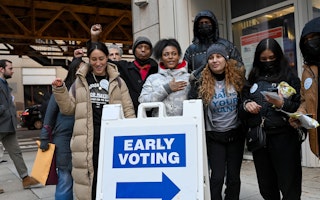Three Myths About the Voting Rights Act
By Laleh Ispahani
Our last election proved once again that the Voting Rights Act of 1965 is the best defense against widespread voter suppression efforts. However, the Supreme Court agreed to hear a case that could do away with the essence of this law—Section 5, which requires states with a history of voter suppression to seek approval before implementing changes to their elections systems. The case, Shelby County v. Holder, was argued yesterday.
Joining forces across sectors, Open Society Foundations grantees prepared for the case with long and careful research and legal analysis. The NAACP Legal Defense and Educational Fund, Inc. and the Constitutional Accountability Center filed briefs. A Leadership Conference on Civil and Human Rights–led coalition also filed a legal brief and created videos and other materials. Other grantees, including the American Constitution Society and others, focused on educating the public and policymakers with issue briefs.
There’s much at stake in the case, including the fundamental question of whether Congress has the power to ensure equal opportunity to participate in our democracy. Given the rally on the courthouse steps before the hearing and the packed-to-capacity courtroom, it was clear that a great and diverse number of people believe that we still need the full power of the Voting Rights Act to maintain democratic equality. The conscience of the civil rights movement, Congressman John Lewis, was there along with Justice Thurgood Marshall’s widow Cecilia Marshall.
While it’s too early to tell how the Court may rule, let's dispel three misimpressions Shelby County supporters created:
Myth 1: Section 5 of the Voting Rights Act unfairly punishes southern states for past wrongs.
In fact, while many of the jurisdictions covered by Section 5 are in the South, there are also states and counties covered by it outside the south, including Texas, Alaska, Arizona, and counties in California, South Dakota, New Mexico, and New York. And the statute is flexible. Since 1982, 18 jurisdictions from nine different states have been added to the Section 5 preclearance regime and almost 200 have bailed out.
Myth 2: Section 2 stands on its own and can prevent discrimination.
In fact, litigation under Section 2 is expensive, time-consuming, and unlike with Section 5, the discriminatory voting laws can’t usually be restrained from taking effect until the matter is settled.
Myth 3: Congress did not engage in a thorough examination of the coverage mechanism when it reauthorized Section 5 in 2006.
In fact, Congress engaged in one of the most extensive legislative processes in its history when it reauthorized Section 5 in 2006. Over a 10-month period, Congress held more than 21 hearings, heard from over 90 witnesses from a wide variety of perspectives, and compiled a record of more than 15,000 pages. In the end, large bipartisan majorities in both Houses of Congress concluded that the evidence clearly established the need to continue Section 5 protections for minority voters.
At the hearing yesterday, Justice Scalia said that when Congress reauthorized the VRA in 2006, it was perpetuating a “racial entitlement.” Ending racial discrimination was not and is not the same as an entitlement. The entitlement that minority voters have is an entitlement to equality at the ballot box. That is the promise of our Constitution.

Laleh Ispahani is managing director of Programs at the Open Society Foundations.


